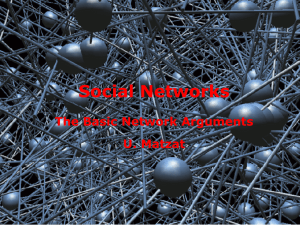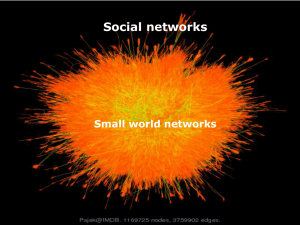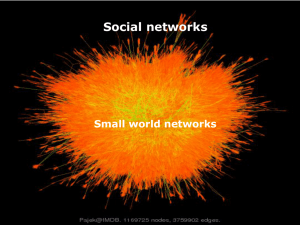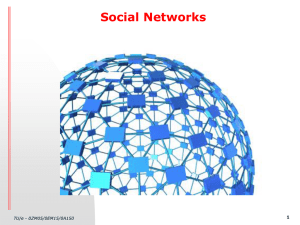Collection of Network Data
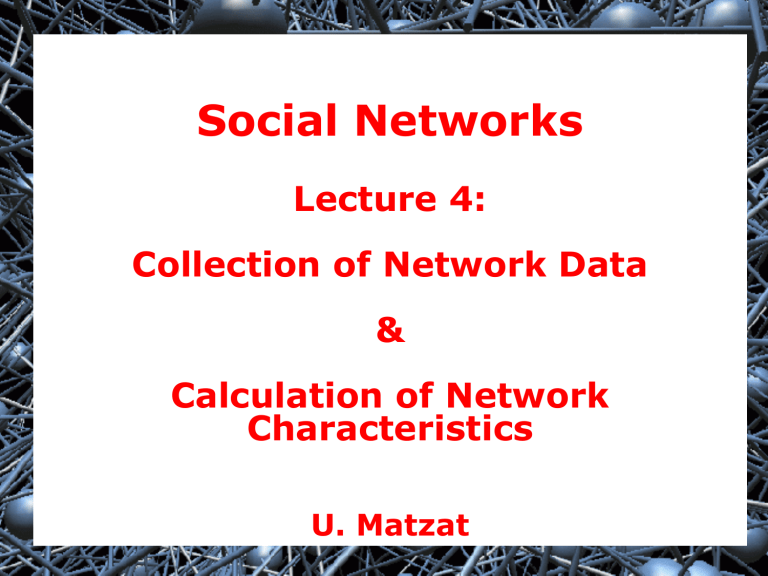
Social Networks
Lecture 4:
Collection of Network Data
&
Calculation of Network
Characteristics
U. Matzat
1
Course design
Aim: knowledge about concepts in network theory, and being able to apply them, in particular in a context of innovation and alliances
-
-
-
-
-
-
Introduction: what are they, why important …
Small world networks
Four basic network arguments
Kinds of network data (collection) & measurement
Business networks
Assignment 1
Social Networks, TU/e - 0ZM05/0EM15/0A150
2
Course outlook - today
4. Methods
-
Kinds of network data: collection (Part I)
-
Typical network concepts: calculation, UCINET software, visualisation (Part II)
Later: Assignments
- complete network analysis
- ego-centered network analysis
Social Networks, TU/e - 0ZM05/0EM15/0A150
3
Part 1 – Collection of Network Data
-
-
-
-
-
in traditional surveys a random sample of units (e.g. managers) is interviewed properties of individuals are correlated to analyze some phenomena (e.g., correlation of age with openness for new ideas) focus on distributions of qualities of the individuals, not on their relations traditional assumption: sampled units (e.g., managers) are independent of each other and not related to each other inappropriate for SNA traditional survey instruments had to be adjusted & new ones had to be developed
4
Social Networks, TU/e - 0ZM05/0EM15/0A150
Collection of Network Data: two main approaches within SNA
1.) ego-centered network analysis : network (of a specific type) from the perspective of a single actor (ego)
2.) complete network analysis : the relations (of a specific type) between all units of a social system are analyzed
-
-
-
-
-
-
the first approach rests on an extension of traditional survey instruments can be combined with random sampling statistical data analyses possible with standard software
(e.g., SPSS) the second approach is new
(usually) cannot be combined with random sampling quantitative case study statistical data analyses with specialized software (e.g.,
UCINET)
5
Social Networks, TU/e - 0ZM05/0EM15/0A150
Ego-centered network data
-
-
-
-
random sample: selection of units (e.g. individuals) out of a population inclusion of one individual does not influence whether another one is also included relationship between units is no criterion of selection respondent (ego) mentions for a relationship of a certain type (e.g. friendship relation) other individuals (alteri) with whom he is related usually the alteri are not within the sample
respondent gives additional information about
-some characteristics of the alteri (age etc.)
-the relations between the alteri crucial: specialized items for the generation of alteri: name-generator
Social Networks, TU/e - 0ZM05/0EM15/0A150
6
name generator for reconstruction of friendship networks in a general population: first step :
" From time to time people discuss questions and personal problems that keep them busy with others. When you think about the last 6 months - who are the persons with whom you did discuss such questions that are of personal importance for you.
Please mention only the first name of the individuals ."
[If respondent mentions less than five names, ask once more:
"Anybody else? " Write down only the first five names.] second step :characterization of alteri (gender, age, etc) and relation between ego and alteri (e.g., strength of relation) third step : -characterization of relation between the different pairs of alter
(e.g., strength of relation)
7
Social Networks, TU/e - 0ZM05/0EM15/0A150
random sample of university researchers
question of interest: how does a researcher’s network look like that brings him into contact with business representatives for collaboration?
reconstruction of four parts of the network from the point of view of the researcher:
within university- within own faculty
within university- outside own faculty
outside university – within business world
[outside university – personal friends, acquaintances etc.]
8
Social Networks, TU/e - 0ZM05/0EM15/0A150
Questionnaire items
Let us suppose that you are convinced that you have an idea, a product or something similar, in which collaboration with a business firm is a sensible and reasonable option.
Do you have any contacts that could be of substantial value for bringing you in touch with a business firm?
0 yes
0 no (continue with question xx)
9
Social Networks, TU/e - 0ZM05/0EM15/0A150
From which of the employees within your faculty do you expect that they can make a substantial contribution with respect to getting you in contact with business firms that might become partners? Mention the most important persons, at most four.
First name Initial of last name
From which of the employees outside your faculty but within your university do you expect that they can make a substantial contribution with respect to getting you in contact with business firms that might become partners? Mention the most important persons, at most four.
First name Initial of last name
10
Social Networks, TU/e - 0ZM05/0EM15/0A150
8.
9.
10.
11.
12
13
5.
6.
7.
14
15
16.
17.
18.
3.
4.
1.
2.
Example (cont)
You mentioned up to 16 names of persons. Please write down the name of the first person mentioned, the second person mentioned, the third person mentioned, etc, until every name is on this list.
Make sure that each name is mentioned once and only once.
..........................................................................
..........................................................................
..........................................................................
..........................................................................
..........................................................................
..........................................................................
..........................................................................
..........................................................................
..........................................................................
..........................................................................
..........................................................................
..........................................................................
..........................................................................
..........................................................................
..........................................................................
..........................................................................
..........................................................................
..........................................................................
Please carefully check this list. Are any persons missing of whom you feel that
– given the questions – they should be included in this list? Persons who are crucial in getting cooperation between you and a business partner going?
If yes, please add these persons to the list (at most two extra persons) and briefly describe your relation to this person.
11
Social Networks, TU/e - 0ZM05/0EM15/0A150
Example (cont): second step
We would like to know how strong your relation with the persons in this list is. A strong relation would be a relation with frequent contact and with a regular exchange of information.
The relation is strong.
The relation is distant.
1.
Jack
2. Jim
9.
10.
11.
12
13
14
15
16.
17.
18.
5.
6.
7.
8.
3 . ….
4.
○
○
○
○
○
○
○
○
○
○
○
○
○
○
○
○
○
○
○
○
○
○
○
○
○
○
○
○
○
○
○
○
○
○
○
○
12
Social Networks, TU/e - 0ZM05/0EM15/0A150
Example (cont): third step
Finally, we would like to ask you about the relations between the listed persons in your network.
Start with the first person in the list. Consider the relation between this person and the other persons in the list. Choose between:
S: strong relation
D: distant relation
0: no relation
Fill out an X if you cannot judge the relationship.
Jim
01
Jack
02
...
03
04
05
06
07
08
09
10
11
12
14
15
16
17
18
Social Networks, TU/e - 0ZM05/0EM15/0A150
13
13
ego-centered network data: data matrix
example:
name generator for three best friends (of two respondents) gender age friend 1 existing? friend 2 existing? friend 3 existing? tie strength 1 tie strength 1-2 gender friend 1 respondent 1 1 30 1 1 1
1 0 respondent 2 2 40 1
…………
…………
…………
0.8 1
0.7 0
1
2
14
Social Networks, TU/e - 0ZM05/0EM15/0A150
ego-centered network data: data matrix
Social Networks, TU/e - 0ZM05/0EM15/0A150
15
ego-centered network data: data matrix
standard data matrix that can be analyzed with the conventional techniques and conventional software (e.g.,
SPSS, STATA etc)
but special type of variables of the data set
some variables describe the respondent
some variables describe the respondent's contacts
some variables describe the relation between the respondent and his contacts
some variables describe relations between members of the respondent's (primary) network
these variables can be used to construct other variables that describe properties of the respondent’s network (size, density etc)
you have to construct these variables: e.g. via “TRANSFORM –
COMPUTE” in SPSS
16
Social Networks, TU/e - 0ZM05/0EM15/0A150
ego-centered network data
ego-centered network data necessary for testing of typical network theories
Example: structural holes hypothesis (ego=company)
“ Innovating companies tend to profit more from new product ideas the more structural holes they have in their collaboration networks with other companies.
“
a test of this hypothesis is impossible with traditional surveys of companies
Social Networks, TU/e - 0ZM05/0EM15/0A150
17
+ random sampling possible
+ generalization to a well-defined population possible
+ for the social scientist easy to use techniques of data analysis
- restriction to those parts of the network that are directly visible to the respondent: the primary network; other characteristics of the network are not taken into account
Social Networks, TU/e - 0ZM05/0EM15/0A150
18
ego-centered network data:
Social Networks, TU/e - 0ZM05/0EM15/0A150
19
ego-centered network data:
Social Networks, TU/e - 0ZM05/0EM15/0A150
20
complete network data:
Social Networks, TU/e - 0ZM05/0EM15/0A150
21
Complete network data
-
-
example: network of informal communication between employees of a project group consisting of 5 persons:
Mr Smith, Mr Jackson, Mr. White, Mrs Moneypenny, Mrs
Brown questionnaire item for Mr Smith:
-
"With whom of the following persons do you now and then chat during a normal working day?" Do you talk with…
-
Mr. Jackson
Mr. White
0 yes 0 no
0 yes 0 no
Mrs Moneypenny 0 yes 0 no
Mrs Brown 0 yes 0 no
-
question is presented to all members of the project group you need to have a complete list of the names of all units
(e.g. individuals) of the social system (e.g. project group) beforehand
Social Networks, TU/e - 0ZM05/0EM15/0A150
22
Complete network data: sociomatrix
Smith
Smith Jackson White Moneypenny
1 1 0 1
Jackson 1
White 0
Moneypenny
Brown
1
0
1
1
0
0
1
1
1
1
0
1
1
0
Brown
0
0
1
0
1
the data matrix is different from the traditional data matrix
every cell ij in the matrix provides information about the relation between units i and j ("from row i to column j")
relation can be symmetric or asymmetric, valued or dichotomous
23
Social Networks, TU/e - 0ZM05/0EM15/0A150
Complete network data:
-
-
-
-
-
-
collection of complete network data impossible for large random samples necessary for many hypotheses that make predictions about structural effects:
" In groups with a high network density the diffusion of innovations takes place more quickly than in groups with a low density ." hypothesis can only be tested with complete network data data matrix of complete network data cannot be analyzed with the conventional data analysis techniques specialized software that offers special techniques is needed
(e.g., UCINET) you can calculate network characteristics of actors and of the whole network you can calculate network characteristics (within UCINET) for actors that can be exported and then combined with other data (e.g., SPSS data)
24
Social Networks, TU/e - 0ZM05/0EM15/0A150
+ all aspects of the structure of relationships between all actors in a social system are taken into account
no random sampling, therefore no generalizations are possible, rather: quantitative case study approach
- other techniques of data analysis necessary
Social Networks, TU/e - 0ZM05/0EM15/0A150
25
Complete network data:
Social Networks, TU/e - 0ZM05/0EM15/0A150
26
Part II: Calculation & visualisation of
(1): in- and outdegree
For complete, valued, directed network data with N actors, and relations from actor i to actor j valued as r ij
, varying between 0 and R .
Centrality and power: outdegree (or: outdegree centrality)
For each actor j: the number of (valued) outgoing relations, relative to the maximum possible (valued) outgoing relations.
OUTDEGREE(i) =
j r ij
/ N.R
Centrality and power: indegree (or: indegree centrality) same, but now consider only the incoming relations
NOTE1: this is a locally defined measure, that is, a measure that is defined for each actor separately
NOTE2: this gives rise to several global network measures, such as (in/out)degree variance
NOTE3: if your network is not directed, indegree and outdegree are the same and called degree
NOTE4: these measures can be constructed in SPSS; no need for special purpose software. Try this yourself!
Social Networks, TU/e - 0ZM05/0EM15/0A150
27
1 = I do not know who this is
2 = I know who it is, but never talked to him/her
3 = I have spoken to this person once or twice
4 = I talk to this person regularly
5 = I talk to this person often
Number of ties :
For each network or for each actor, the number of ties above a certain threshold
(say, all ties with a value above 3)
Number of weak ties (remember Mark Granovetter?) :
For each network or for each actor, the number of ties above and below a certain threshold
(say, only ties with values 2 and 3)
Try creating this one yourself in SPSS (try using ‘recode’)
28
Social Networks, TU/e - 0ZM05/0EM15/0A150
Network measures (3): closeness
Centrality and power again: closeness
= Average distance to all others
in the network
Note: a shortest path from i to j is called a “geodesic”
Define distance Dij from i to j as:
* Minimum value of a path from i to j
For every actor i, average distance =
j D ij
/ N
NOTE: THIS IS NOT EASY TO DO ANYMORE IN SPSS!
29
Social Networks, TU/e - 0ZM05/0EM15/0A150
Density
( J. Coleman: “Dense networks provide social capital.”)
For each network: the number of (valued) relations, relative to the maximum possible number of (valued) relations.
=
i,j r ij
/ N (N-1) R (directed, valued ties)
NOTE: normally only of use if your data consist of multiple networks
(alliance networks in different sectors or countries / friendship networks in school classes / …)
NOTE: this is still doable in SPSS
30
Social Networks, TU/e - 0ZM05/0EM15/0A150
Network measures (5):
Subgroup
Models (Cohesion)
-
-
aim: description of cohesive subgroups within the larger network general and common idea: a subgroup has a certain degree of cohesiveness (direct ties, strong ties) can also be used to make predictions about the diffusion of innovations according to the cohesion model (which pairs of actors influence each other?)
-
which companies constitute a subgroup within the network?
which companies are in many subgroups?
how many subgroups do exist?
31
Social Networks, TU/e - 0ZM05/0EM15/0A150
-
reachability if a path exists between 2 nodes then these nodes are called reachable
path length number of lines of a path (dichotomous data)
example: path length 4 2 1 3 = 3 geodesic distance between two nodes
there can be more than one path between two nodes, the different paths can have different lengths
-
-
d(i,j)=length of the shortest path between two nodes i and j example: 4 2 1 3 = 3 , d(i,j)=3 if there exists no shorter path between i and j d(i,j)= if i,j are not reachable
32
Social Networks, TU/e - 0ZM05/0EM15/0A150
Subgroups: Terminology....
-
completeness of a graph a graph is complete if all pairs of nodes (i,j) are reachable with d(i,j)=1 connectedness a graph is connected if for every pair (i,j) d(i,j)<
-
subgraphs a subgraph Gs consists of a subset Ns N and its lines Ls L that connect all {i,j} Ns
Maximality a subgraph is maximal with respect to some property (e.g., maximal with regard to completeness) if that property holds for the subgraph, but does no longer hold if any additional node and the lines incident with the node are added
33
Social Networks, TU/e - 0ZM05/0EM15/0A150
1
5
2
3
4
6
7 maximal complete subgraph Gs
Ns={1,2,3,4,5} and the ties between them
Social Networks, TU/e - 0ZM05/0EM15/0A150
34
Cliques a cliques is a maximal complete subgraph that consists of at least three nodes
2 7
1
3 4
Which cliques?
5
{1,2,3}, {1,3,5}, {3,4,5,6}
6 cliques can overlap, a clique can not be part of a larger clique because of the maximality condition impossible to calculate with SPSS!
35
Social Networks, TU/e - 0ZM05/0EM15/0A150
A
7
This was covered in the 3 rd lecture
Ron Burt: “Structural holes create value”
1
B
3
2
James
Robert
C
6
Robert will do better than
5
James, because of:
-informational benefits
-“tertius gaudens” (entrepreneur)
-autonomy
4
Social Networks, TU/e - 0ZM05/0EM15/0A150
8
36
Burt, R.S. (1995)
NOTE: structural holes can be defined on egonetworks!
Burt splits his structural holes measure in four separate ones:
[1] effective size
[2] efficiency (= effective size / total size)
[3] constraint (degree to which ego invests in alters who themselves invest in other alters of ego)
[4] hierarchy (adjustment of constraint, dealing with the degree to which constraint on ego is concentrated in a single actor)
Social Networks, TU/e - 0ZM05/0EM15/0A150
37
Structural holes: Effective size & efficiency
A
B
F
We calculate effective
size and efficiency for actor G
E
C
G
D
(note: because this is an ego-network, all would be different if we would have chosen, for instance, actor A)
Ego=G,
Size[G]=6
A B C D E F Eff.
size
Efficiency redundancy 3/6 2/6 0/6 1/6 1/6 1/6 4.67
78%
Or, the same but a bit easier: Effective size = size - average degree of ego’s alters in ego’s network (excluding ties to ego).
Here:
6 - {3 (A) + 2(B) + 0(C) + 1(D) + 1(E) + 1(F)}/6 = 6 - 1.33 = 4.67
38
Social Networks, TU/e - 0ZM05/0EM15/0A150
Defining constraint: actors must divide their attention
E
A
G
F
B
D E
F
G
C
D
A
B
A
0.33
0
0
0.50
0.50
0.17
B
0.25
0
0.50
0
0
0.17
0
0
0
0.17
C
0
0.0
D
0
0.33
0
0
0
0.17
C
E
0.25
0
0
0
0
0.17
F
0.25
0
0
0
0
G
0.25
0.33
1.00
0.50
0.50
0.50
0.17
The assumption is that actors can only invest a certain amount of time and energy in their contacts, and must divide the available time and energy across contacts.
If not explicitly measured, we assume all contacts are invested in equally.
39
Social Networks, TU/e - 0ZM05/0EM15/0A150
Constraint
i p iq p ij q p qj j
Actor i is constrained in his relation with j to the extent that:
[a] i invests in another contact q who …
[b] invests in i’s contact j
Total investment of i in j =
Pij + q (piq pqj)
“Since this also equals i’s lack of structural holes, constraint of i in j is taken to equal”
( Pij + q (piq pqj) )2
40
Social Networks, TU/e - 0ZM05/0EM15/0A150
Calculating constraint using matrices (1)
Adjacency matrix
P =
(see two slides ago) all investment from i in j in 1 step c1 c2 c3 c4 c5 c6 c7 r1 0 .25 0 0 .25 .25 .25
r2 .333 0 0 .333 0 0 .333
r3 0 0 0 0 0 0 1 r4 0 .5 0 0 0 0 .5
r5 .5 0 0 0 0 0 .5
r6 .5 0 0 0 0 0 .5
r7 .17 .17 .17 .17 .17 .17 0
Matrix product
P 2 = P*P = all investments from i in j in 2 steps c1 c2 c3 c4 c5 c6 c7 r1 .37575 .0425 .0425 .12575 .0425 .0425 .33325
r2 .05661 .30636 .05661 .05661 .13986 .13986 .24975
r3 .17 .17 .17 .17 .17 .17 0 r4 .2515 .085 .085 .2515 .085 .085 .1665
r5 .085 .21 .085 .085 .21 .21 .125
r6 .085 .21 .085 .085 .21 .21 .125
r7 .22661 .1275 0 .05661 .0425 .0425 .52411
Social Networks, TU/e - 0ZM05/0EM15/0A150
41
Calculating constraint using matrices (2)
P + P 2 =
All investments from i to j in
1 or 2 steps
Pij + q (piq pqj)
Hadamard matrix product
(P+P 2 ) 2h
= P+P 2 squared element wise
Constraint(i,j) can be read from this matrix
Social Networks, TU/e - 0ZM05/0EM15/0A150 c1 c2 c3 c4 c5 c6 c7 r1 .37 .29 .04 .12 .29 .29 .58
r2 .38 .30 .05 .38 .13 .13 .58
r3 .17 .17 .17 .17 .17 .17 1
R4 .25 .58 .08 .25 .08 .08 .66
r5 .58 .21 .08 .08
.21 .21 .62
r6 .58 .21 .08 .08 .21 .21 .62
r7 .39 .29 .17 .22 .21 .21 .52
c1 c2 c3 c4 c5 c6 c7 r1 .141 .085 .002
.015 .085 .085 .340
r2 .151 .093 .003 .151 .019 .019 .339
r3 .028 .028 .028 .028 .028 .028 1 r4 .063 .342 .007 .063 .007 .007 .444
r5 .342 .044 .007 .007 .044 .044 .390
r6 .342 .044 .007 .007 .044 .044 .390
r7 .157 .088 .028 .051 .045 .045 .274
(0.666) 2
= 0.444
Etc …
42
Calculating constraint using matrices (3)
Total constraint for actor i = sum of all constraints C ij with j i c1 c2 c3 c4 c5 c6 c7 r1 .141 .085 .002
.015 .085 .085 .340
r2 .151 .093 .003 .151 .019 .019 .339
r3 .028 .028 .028 .028 .028 .028 1 r4 .063 .342 .007 .063 .007 .007 .444
r5 .342 .044 .007 .007 .044 .044 .390
r6 .342 .044 .007 .007 .044 .044 .390
r7 .157 .088 .028 .051 .045 .045 .274
= 0.755 <- Constraint(1)
= 0.779 <- Constraint(2)
= 1.173 <- Constraint(3)
= 0.934 <- Constraint(4)
= 0.879 <- Constraint(5)
= 0.879 <- Constraint(6)
= 0.691 <- Constraint(7)
43
Social Networks, TU/e - 0ZM05/0EM15/0A150
-
Hierarchy
= degree to which constraint is concentrated in a single actor
-
Cij = constraint from j on i (as on previous pages)
-
-
N = number of contacts in i’s network
C = sum of constraints across all N relationships
-
Hierarchy (i)
j
C
C ij
N
ln
C
C ij
N
N ln( N )
-
-
Minimum = 0 (all i’s constraints are the same)
Maximum = 1 (all i’s constraint is concentrated in a single contact)
Social Networks, TU/e - 0ZM05/0EM15/0A150
44
Network concepts: Ucinet Software
Social Networks, TU/e - 0ZM05/0EM15/0A150
45
Network concepts: Ucinet Software
Social Networks, TU/e - 0ZM05/0EM15/0A150
46
Network concepts: Ucinet Software
Social Networks, TU/e - 0ZM05/0EM15/0A150
47
Network concepts: Ucinet Software
Social Networks, TU/e - 0ZM05/0EM15/0A150
48
Network concepts: Ucinet Software
Social Networks, TU/e - 0ZM05/0EM15/0A150
49
Network concepts: Ucinet Software
Social Networks, TU/e - 0ZM05/0EM15/0A150
50
Network concepts: Ucinet Software
Social Networks, TU/e - 0ZM05/0EM15/0A150
51
Network concepts: Ucinet Software
Social Networks, TU/e - 0ZM05/0EM15/0A150
52
Network concepts: Ucinet Software
Social Networks, TU/e - 0ZM05/0EM15/0A150
53
To Do:
Read the chapters 6, 9, 10-11 of Hanneman &
Ridle on network techniques
Download/install Ucinet and the talk.dl data
Try it out!
(Install SPSS and fresh up your SPSS knowledge!)
54
Social Networks, TU/e - 0ZM05/0EM15/0A150
